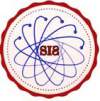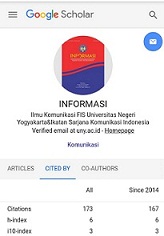KRITIK TERHADAP TEORI SPIRAL OF SILENCE: KOMUNIKASI MASYARAKAT MADURA DALAM KONFLIK SUNNI-SYI'AH DI SAMPANG
DOI:
https://doi.org/10.21831/informasi.v46i1.9645Keywords:
Courage Communication, Conflict, Spiral of SilenceAbstract
The sunni-shiite conflict that occurred in Sampang, Madura has yet to be resolved.
Therefore, this study aims to determine the process to fight the opinion that a conflict
occurred between the two. The research was conducted in the Karanggayam village,
Omben and Blu'uran village, Karang Penang, Sampang, Madura and mansions Puspa
Agro Sidoarjo with the phenomenological method. That is, the phenomenon under
study will be illustrated by personal experience of informants through interviews. To
determine the validity of the data, then the triangulation on the data obtained. Results
are the conflicts caused by differences of opinion between the two groups regarding the
moral values of Islam. As migrant groups, Shiites openly against the public opinion
which is believed by the local community (Sunni). The above measures, social isolation
and threats carried out by the Sunnis that Shi'ites leave Shi'ism and move to the Sunnis.
Nevertheless, Shiites remained adamant and against the social isolation. The action
taken by the Shi'ite group contradicts with the assumption of spiral of silence theory,
the theory which explains that there is a person's tendency to adhere to public opinion
for fear of being ostracized.
Konflik Sunni-Syi'ah yang terjadi di Sampang, Madura sampai saat ini belum dapat
diselesaikan. Oleh karena itu penelitian ini bertujuan untuk mengetahui proses
pertarungan pendapat yang terjadi hingga menimbulkan konflik diantara keduanya.
Adapun penelitian ini dilakukan di desa Karanggayam, Omben, dan desa Blu'uran,
Karang Penang, Sampang, Madura dan rumah susun Puspa Agro Sidoarjo dengan
metode fenomenologi. Artinya, fenomena yang diteliti akan digambarkan dengan
pengalaman pribadi informan melalui wawancara mendalam. Untuk mengetahui
keabsahan data, maka dilakukan triangulasi sumber pada data yang didapat. Hasil yang
ditemukan adalah konflik tersebut terjadi akibat adanya perbedaan pendapat diantara
kedua kelompok mengenai nilai-nilai ajaran Islam. Sebagai kelompok pendatang, Syi'ah
secara terang-terangan melawan pendapat umum yang diyakini oleh masyarakat sekitar
(Sunni). Atas Tindakan tersebut, berbagai ancaman dan isolasi sosial dilakukan oleh
kelompok Sunni agar kelompok Syi'ah meninggalkan ajaran Syi'ah dan berpindah ke
Sunni. Kendati demikian, Syi'ah tetap bersikukuh dan melawan isolasi sosial tersebut.
Tindakan yang diambil oleh kelompok Syi'ah bertentangan dengan asumsi teori spiral
keheningan, dimana teori tersebut menjelaskan bahwa ada kecenderungan seseorang
untuk patuh terhadap pendapat umum karena takut dikucilkan.
References
Berger, Peter L. & Luckmann, Thomas. 1966. The Social Construction of Reality. England: Penguin Group.
Bruinessen, Martin, van. 2013. Rakyat Kecil, Islam, dan Politik. Yogyakarta: Gading.
Dharma, Ferry A.. 2016. Eklusi dan Hambatan Komunikasi dalam Konflik Sunni-Syi'ah di Sampang, Madura. Tesis. Surakarta: UNS.
Filayati, Citra Nita. 2013. "Analisis Wacana Kritis terhadap Pemberitaaan Kasus Sampang (Aliran Sunni dan Syiah) dalam Harian Suara Merdeka (edisi Agustus–September 2012)". Skripsi. Semarang: IAIN Walisongo.
Fitriani, Vita. 2013. Komunikasi Antar Budaya dalam Kehidupan Pesantren (Studi Pada Santri Etnis Jawa, Madura dan NTT Pondok Pesantren Nurul Falah Surabaya). Skripsi. Surabaya: UIN Sunan Ampel Surabaya.
Hall, Edward T. 1976. Beyond Culture. New York: Doubleday.
Husserl, Edmund. 1983. Ideas Pertaining to A Pure Phenomenological Philosophy. Translated by: F. Kersen. Boston: Martinus Nijhoff Publishers.
Jonge, Huub de. 1989. MADURA dalam empat zaman: pedagang, perkembangan ekonomi dan Islam. Jakarta: PT. Gramedia.
Judith N. Martin & Nakayama K. 2010. Intercultural Communication in Contexts: Fitfth Edition. New York: The McGraw-Hill Companies.
Kontras Surabaya. 2012. Laporan Investigasi dan Pemantauan Kasus Syi'ah Sampang. Surabaya: Kontras.
Littlejohn, Stephen W., dan Karen A. Foss. 2011. Theories Of Human Communication. Tenth Edition. Albuquerque. New Mexico: Wadsworth Publishing Company.
McCornack, et. al. 1996. Speaking of Informatioan Manipulation: Acritical Rejonder. Communication Monographs. Vol. 63, P. 83-92.
Muqoyyidin, Andik W. 2012. Potret Konflik Bernuansa Agama di Indonesia (Signifikansi Model Resolusi Berbasis Teologi Transformatif). Analisis. Vol. XII, No. 2. Hlm: 315-340.
Noelle-Neumann, E. 1974. The spiral of silent: a theory of public. The journal of communication. Vol. 24, No. 2, Hlm: 43-51.
Raffles, Thomas, S. 1817. The History of Java Vol. II. London: Black, Parbury, and Allen.
Samovar, Larry A., Porter, Richard E., & McDaniel, Edwin R. 2009. Communication Between Cultures. Boston: Wadsworth.
Shoemaker, Pamela J., Breen, Michael, & Stemper, Marjorie. 2000. Fear of Social Isolation: Testing an Assumption from the Spiral of Silence. Irish Communication Review. Vol 8, P. 65- 78.
Tajfel, Henri. 1981. Human Groups and Social Categories. London: Cambridge University Press.
Vallerand, R. J., Pelletier, L. G., et. al. 1992. Azjen & Fishbein's Theory of Reaoned Action as applied to moral behavior: A confirmatory analysis. Journal of Personality and Social Psychology. Vol. 62, No. 1, P. 98 – 109.
West, Rchard, and Turner Lynn, H. 2010. Introducting Communication Theory: Analysis Aplication fourth edition. New York: McGraw-Hill.
Withers, Bill & Lewis D. Keami. 2003. Conflict and Communication. New York: AMACOM.
Wiyata, A. Latief. 2013. Mencari Madura. Jakarta: Bidik Phronesis Publisihing.
Downloads
Published
Issue
Section
License
Authors who publish with this journal agree to the following terms:- Authors retain copyright and grant the journal right of first publication with the work simultaneously licensed under a Creative Commons Attribution License that allows others to share the work with an acknowledgement of the work's authorship and initial publication in this journal.
- Authors are able to enter into separate, additional contractual arrangements for the non-exclusive distribution of the journal's published version of the work (e.g., post it to an institutional repository or publish it in a book), with an acknowledgement of its initial publication in this journal.
- Authors are permitted and encouraged to post their work online (e.g., in institutional repositories or on their website) prior to and during the submission process, as it can lead to productive exchanges, as well as earlier and greater citation of published work (See The Effect of Open Access).





















